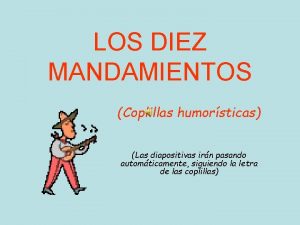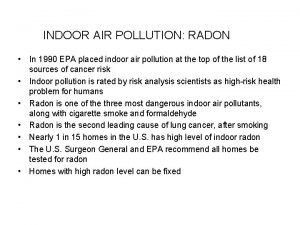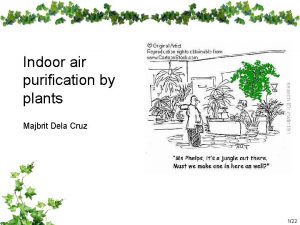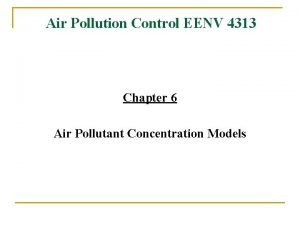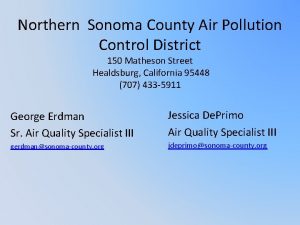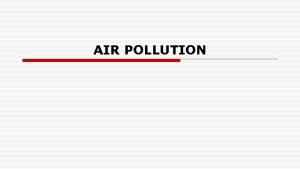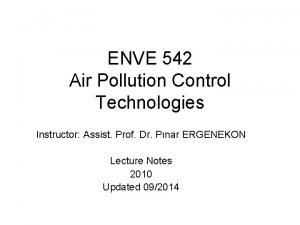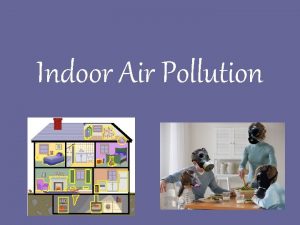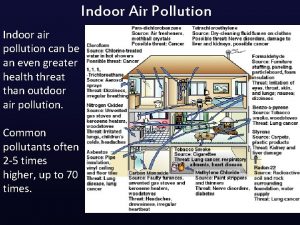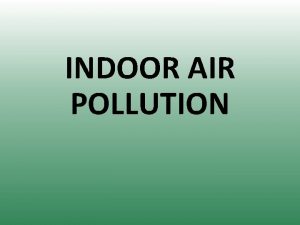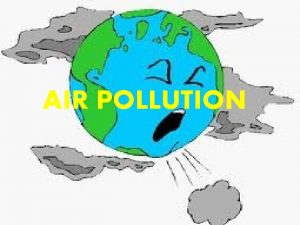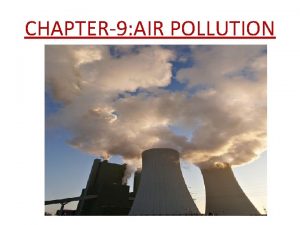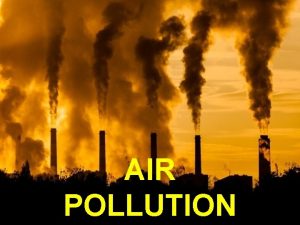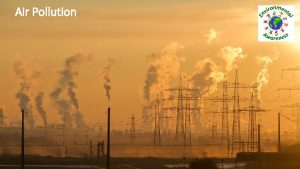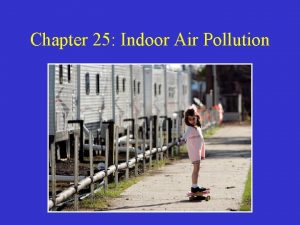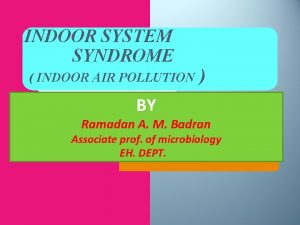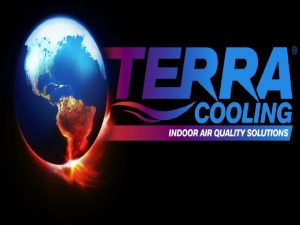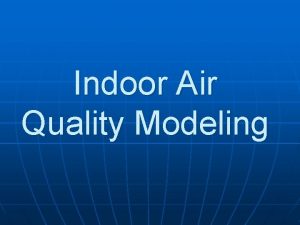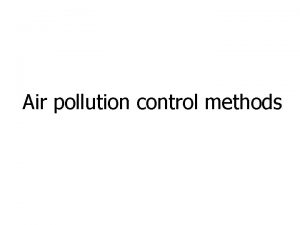Pollution Control Indoor Air Pollution Cha 15 Pollution
















- Slides: 16

Pollution Control & Indoor Air Pollution Cha. 15

Pollution Control ● Best way = avoid emissions in the first place o o use fuels with fewer impurities use low sulfur coal or oil (more $) increase efficiency & conservation Develop alternative energy sources not dependent on combustion

Control of Sulfur and Nitrogen Oxide Emissions ● Remove SO 2 from coal exhaust during combustion = fluidized bed combustion. Coal is burned near calcium carbonate which reduces sulfur emissions. o Ca. CO 3 absorbs SO 2 and produces calcium sulfate which is used to make gypsum and sheetrock ● Decrease NOx by decreasing burn temps and amt. of oxygen used o incomplete combustion reduces efficiency and releases more particulates and CO : [ ● Catalytic converters in all cars after 1975 reduce NOx and CO, also reduce lead because metals in converter can’t be exposed to lead ● Improvements in combustion technology of power plants and factories

Control of Particulate Matter ● Removal of PM is the most common means of pollution control, sometimes removes sulfur in the process ● Easiest method is gravitational settling, relies on gravity to remove particles as exhaust travels through smokestack o Ash must be disposed of in a landfill

Baghouse Filter Fabric filter can remove almost 100% of PM emissions

Electrostatic Precipitator Uses electrical charge to separate particulate matter Removes majority of PM

The Scrubber Combo of water and air to separate and remove particles Used also to reduce SO 2 emissions * All 3 types of pollution control devices require extra energy and increase the resistance of air flow. They require the use of more fuel and increase CO 2 emissions : / *

Innovative Pollution Control Ideas ● ● ● Reduce amt. of gasoline spilled at fill stations Restrict evaporation of dry cleaning fluid Restrict use of lighter fluid (a VOC) for starting charcoal grills Reduce wood burning stoves or fireplaces California discussed reducing # of bakeries, emissions from rising bread contain VOCs ● Reduce auto use o Mexico city cars driven every other day (even and odd license plates) o China Beijing olympics, expand public transportation, motor vehicle restrictions, shut down industries to reduce photochemical smog o Carpool lanes o Tolls

Clean Air Act, reducing SO 2 ● Amendments to allow free-market to reduce SO 2 emissions. o Buying and selling of allowances that authorize the owner to emit a certain amt. of sulfur o One allowance = 1 ton of SO 2 a year o Awarded proportionally to amt of sulfur emitted before 1990 o Must have allowances at least equal to emissions or fined o Bought and sold on the open market by anyone o Overtime amount of allowances distributed each year are reduced o U. S. declined from 26 million tons in 1982 to 11. 4 million tons 2008

Indoor Air Pollutants ● Indoor air pollution causes more deaths each year than outdoor air pollution ● Much worse in developing countries o World Health Organization estimates indoor air pollution is responsible for more than 1. 6 million deaths annually worldwide, and 56% of those deaths occur among children less than 5 years old o 90% of deaths from indoor air pollution occur in developing countries

Indoor Pollution Developed World ● Spend more time indoors ● More insulation to decrease energy consumption means more trapped air ● Materials in home made from plastics give off vapors ● New house building materials

Asbestos ● Long thin fibrous silicate mineral with insulating properties ● Used as insulator on steam and hot water pipes, in shingles ● Respiratory disease and lung cancer ● Manufactured form stable, but harmful when disturbed ● No longer used as insulating material, but in older buildings

Carbon Monoxide ● Malfunctioning exhaust systems on household heaters (natural gas heaters) ● CO binds with hemoglobin more efficiently than O 2, interferes with oxygen transport in blood

VOCs in home products ● Formaldehyde used to manufacture building products, particle board and carpeting glue o New houses, pressed wood for cabinets o New carpet smell o Overtime can cause burning sensation in eyes and throat and breathing difficulties and sometimes asthma o Has caused cancer in lab animals, could be human carcinogen ● Detergents, dry-cleaning, deodorizers, plastic, fabric, carpets

Radon ● Radioactive gas that occurs naturally from decay of uranium exists in rocks and soils ● Seeps into homes from cracks in foundation, drinking groundwater ● Decays and attaches to dust particles ● EPA estimates 21, 000 people die/year of radon induced lung cancer, runner-up to smoking ● Test homes, increase ventilation, seal cracks

Sick Building Syndrome ● Newer buildings have more insulation ● Builds up toxic compounds and pollutants in a confined space ● Contain products made with synthetic materials ● Headaches, nausea, throat and eye irritations, fatigue ● 4 reasons o inadequate ventilation o chemicals from glues, carpet, furniture, cleaning supplies, copy machines o Vehicle exhaust through air intakes o bio contamination, molds and pollen
 Cha cha cha con el jaleo del tren letra
Cha cha cha con el jaleo del tren letra Indoor air pollution examples
Indoor air pollution examples Radon indoor air pollution
Radon indoor air pollution Prevention of indoor air pollution
Prevention of indoor air pollution Indoor air pollution sources
Indoor air pollution sources Country stomp line dance
Country stomp line dance Chapter 12 air section 1
Chapter 12 air section 1 Chapter 12 air section 1 what causes air pollution
Chapter 12 air section 1 what causes air pollution Hubungan air dengan tanah
Hubungan air dengan tanah Erg (air pollution control) ltd
Erg (air pollution control) ltd Air pollution control engineering noel de nevers solution
Air pollution control engineering noel de nevers solution Northern sonoma county air pollution control district
Northern sonoma county air pollution control district Air pollution control methods
Air pollution control methods Air pollution control technology
Air pollution control technology Trbonet indoor
Trbonet indoor Batting cages baltimore
Batting cages baltimore Indoor and outdoor sports
Indoor and outdoor sports
